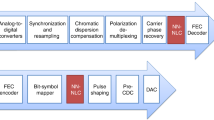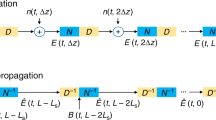Abstract
We propose a less complex neural network that estimates and equalizes the nonlinear distortion of single frequency dual polarization data transmitted through a single mode optical fiber. We then analyze the influence of the size of the input data symbol window on the neural network design and the enhancement of the quality factor (Q-factor) that can be achieved by integrating the neural network with a perturbative nonlinearity compensation model. We significantly reduce the complexity of the neural network by determining the most significant inputs for the neural network from the self-phase modulation terms (intra-cross phase modulation and intra-four wave mixing) in the model. The weight matrices of the neural network are determined without prior knowledge of the system parameters while the complexity of the network is reduced in two stages through weight trimming technique and principle component analysis (PCA). Applying our procedure to a 3200 km double polarization 16-QAM optical system yields a ≈ 0.85 dB Q-factor enhancement with a 35% smaller number of inputs compared to previous designs.







Similar content being viewed by others
References
Agrawal, G.P.: Nonlinear Fiber Optics. Elsevier, Amsterdam (2006)
Averyanov, E., Redyuk, A., Sidelnikov, O., Soroklna, M., Fedoruk, M., Turitsyn, S.: Perturbative machine learning technique for nonlinear impairments compensation in WDM systems. In: 2018 European Conference on Optical Communication (ECOC) (2018)
Cartledge, J.C., Guiomar, F.P., Kschischang, F.R., Liga, G., Yankov, M.P.: Digital signal processing for fiber nonlinearities [Invited]. Opt. Express 25, 1916–1936 (2017)
Gao, Y., Cartledge, J.C., Downie, J.D., Hurley, J.E., Pikula, D., Yam, S.S.-H.: Nonlinearity compensation of 224 Gb/s dual-polarization 16-QAM transmission over 2700 km. IEEE Photon. Technol. Lett. 25, 14–17 (2013)
Goodfellow, I., Bengio, Y., Courville, A.: Deep Learning. The MIT Press, Cambridge (2017)
Häger, C., Pfister, H.D.: Nonlinear interference mitigation via deep neural networks. In: Optical fiber communication conference (2018)
Ip, E., Kahn, J.M.: Compensation of dispersion and nonlinear impairments using digital backpropagation. J. Lightwave Technol. 26, 3416–3425 (2008)
Kamalov, V., Jovanovski, L., Vusirikala, V., Zhang, S., Yaman, F., Nakamura, K., Inoue, T., Mateo, E., Inada, Y.: Evolution from 8QAM live traffic to PS 64-QAM with neural-network based nonlinearity compensation on 11000 km open subsea cable. In: Optical Fiber Communication Conference Postdeadline Papers (2018)
Kingma, D., Ba, J.: Adam: a method for stochastic optimization. In: International Conference on Learning Representations (2014)
Liga, G., Xu, T., Alvarado, A., Killey, R.I., Bayvel, P.: On the performance of multichannel digital backpropagation in high-capacity long-haul optical transmission. Opt. Express 22, 30053–30062 (2014)
Liodakis, G., Arvanitis, D., Vardiambasis, I.: Neural network-based digital receiver for radio communications. WSEAS Trans. Syst. 3(10), 3308–3313 (2004)
Mata, J., Miguel, I.D., Durán, R.J., Merayo, N., Singh, S.K., Jukan, A., Chamania, M.: Artificial intelligence (AI) methods in optical networks: a comprehensive survey. Opt. Switch. Network. 28, 43–57 (2018)
Schmidhuber, J.: Deep learning in neural networks: an overview. Neural Netw. 61, 85–117 (2015)
Sidelnikov, O., Redyuk, A., Sygletos, S.: Equalization performance and complexity analysis of dynamic deep neural networks in long haul transmission systems. Opt. Express 26, 32765 (2018)
Silva, E.P.D., Yankov, M.P., Ros, F.D., Morioka, T., Oxenlowe, L.K.: Perturbation-based FEC-assisted Iterative nonlinearity compensation for WDM systems. J. Lightwave Technol. 37, 875–881 (2019)
Stegun, I.A., Abramowitz, M.: Handbook of Mathematical Functions: with Formulas, Graphs, and Mathematical Tables. US Government printing office, Washington (1972)
Tao, Z., Dou, L., Yan, W., Li, L., Hoshida, T., Rasmussen, J.C.: Multiplier-free intrachannel nonlinearity compensating algorithm operating at symbol rate. J. Lightwave Technol. 29, 2570–2576 (2011)
Wang, D., Zhang, M., Fu, M., Cai, Z., Li, Z., Han, H., Cui, Y., Luo, B.: Nonlinearity mitigation using a machine learning detector based on k-nearest neighbors. IEEE Photon. Technol. Lett. 28, 2102–2105 (2016)
Zhang, S., Yaman, F., Nakamura, K., Inoue, T., Kamalov, V., Jovanovski, L., Vusirikala, V., Mateo, E., Inada, Y., Wang, T.: Field and lab experimental demonstration of nonlinear impairment compensation using neural networks. Nat. Commun. 10, 3033 (2019)
Acknowledgements
The Natural Sciences and Engineering Research Council of Canada (NSERC) are acknowledged for financial support.
Author information
Authors and Affiliations
Corresponding author
Additional information
Publisher's Note
Springer Nature remains neutral with regard to jurisdictional claims in published maps and institutional affiliations.
Rights and permissions
About this article
Cite this article
Melek, M.M., Yevick, D. Nonlinearity mitigation with a perturbation based neural network receiver. Opt Quant Electron 52, 450 (2020). https://doi.org/10.1007/s11082-020-02565-5
Received:
Accepted:
Published:
DOI: https://doi.org/10.1007/s11082-020-02565-5




